Use scenarios and applications of color steel single sheet
In the construction market, balancing functionality, affordability, and sustainability remains a key priority. For projects seeking efficient construction, low maintenance costs, and a long lifespan, color steel single sheet, with their unique technical advantages and application flexibility, are becoming the preferred material for roofs and walls in industrial, commercial, and residential buildings.
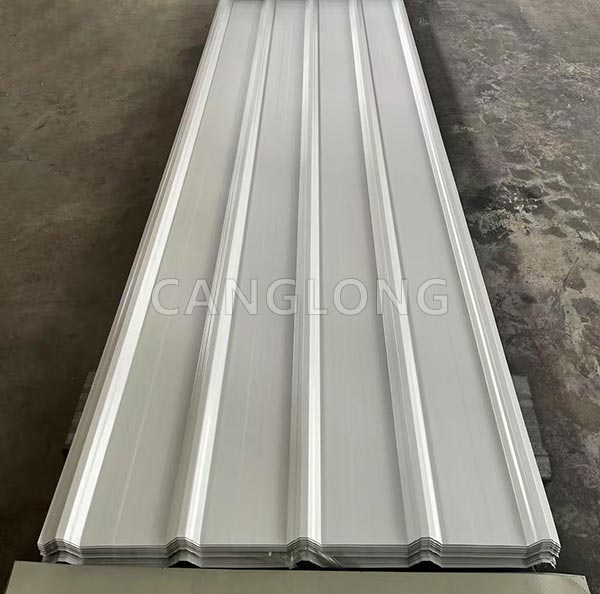
Ⅰ. The Core Structure of Color Steel Single Sheet
Color steel single sheet is essentially metal-based composite panels. Their structural design deeply integrates mechanical properties and functional requirements. They typically consist of the following five layers:
Base Metal: The core supporting layer, typically made of hot-dip galvanized steel (GI) or galvanized steel (GL), typically 0.3-0.8mm thick. The galvanized layer (zinc content ≥ 275g/㎡) or galvanized layer (55% aluminum, 43% zinc) significantly enhances the corrosion resistance of the base metal through sacrificial anodic protection. Even if the surface coating is partially damaged, the coating can still prevent oxidation and extend the overall life of the steel plate.
Primer: The first line of defense applied to the substrate surface, typically an epoxy or polyurethane coating with a thickness of approximately 5-10μm. Its function is to strengthen the bond between the substrate and the intermediate coating and provide initial rust and chemical resistance.
Topcoat: A critical layer that determines the appearance and weather resistance of the sheet. Common types include polyester (PE), silicone-modified polyester (SMP), high-durability polyester (HDP), and polyvinylidene fluoride (PVDF). Topcoat thickness is typically 15-25μm and must ensure color stability (color retention ≥ 15 years), UV resistance, and scratch resistance.
Optional Protective Film: Some high-end products may include a PET or PE film over the topcoat layer. This film is primarily used to prevent scratches during transportation and installation and can be removed after application. Profiled Shape: A corrugated, trapezoidal, or V-shaped profile formed through a roller-pressing process (common wave heights range from 18-35mm and wave spacing from 60-120mm). This design not only enhances the rigidity of the sheet (spans can reach 1.5-3m without additional support) but also optimizes drainage, allowing rainwater to drain quickly along the wave crests and prevent water accumulation and penetration.
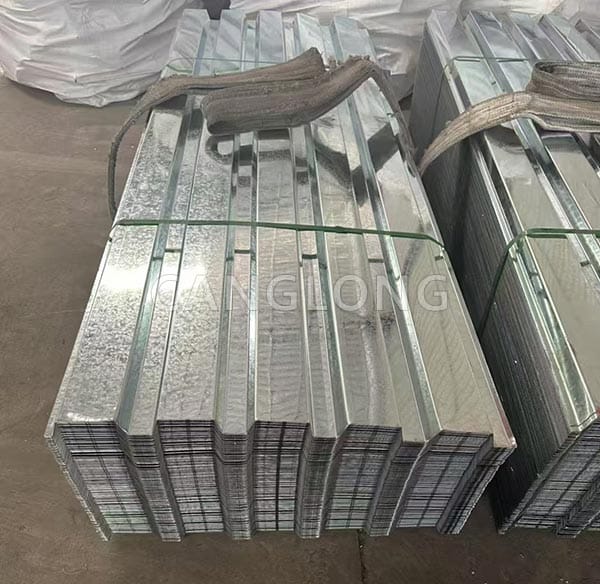
II. Classification of Color Steel Single Sheet
Depending on the coating formula, substrate type, and corrugated design, color steel single sheet can be categorized into four major types, allowing users to flexibly choose based on climate conditions, budget, and application.
2.1. Classification by Coating System
Polyester (PE) color-coated steel sheet: The most economical option, costing approximately one-third of PVDF, it is suitable for dry, low-rainfall regions with low UV exposure (such as temperate continental climates). With a weather resistance of approximately 10-15 years, it is suitable for temporary structures or industrial plants where color is not a priority.
Silicone-modified polyester (SMP): By adding silicone resin, the topcoat’s hardness and weather resistance are enhanced, extending weatherability to 15-20 years. Its scratch resistance surpasses that of PE, making it suitable for moderate climates (such as Mediterranean and subtropical monsoon climates).
High-durability polyester (HDP): Utilizing modified polyester resin and UV absorbers, it offers weatherability of up to 20-25 years, balancing cost and longevity, making it a popular choice in the European and American markets.
Polyvinylidene fluoride (PVDF): A fluorine-containing coating imparts exceptional weather resistance (retaining color and gloss for over 25 years) and offers excellent resistance to UV rays, acids, and alkalis. It is suitable for use in extreme climates (such as tropical rainy regions, coastal areas with high salt fog, or high-temperature desert regions).
2.2. Classification by Wave Design
Corrugated: Classic wave forms (e.g., trapezoidal and sine waves), with high wave heights (28-35mm), strong lateral rigidity, and suitable for large-span roofs (e.g., warehouses and gymnasiums). High drainage efficiency (discharge rate ≥ 15L/min per meter of width).
Trapezoidal: Wave peaks and troughs are stepped, with lower wave heights (18-25mm), but superior lateral stability. Suitable for wall enclosures or lightly loaded roofs (e.g., prefabricated homes and farmers’ markets).
Deep Vee: Wave heights can reach over 40mm, with sharp peaks and excellent wind-uplift resistance (capable of withstanding typhoons of force 12 and above). Commonly found in coastal areas with high wind pressure (e.g., Southeast Asia and the Caribbean).
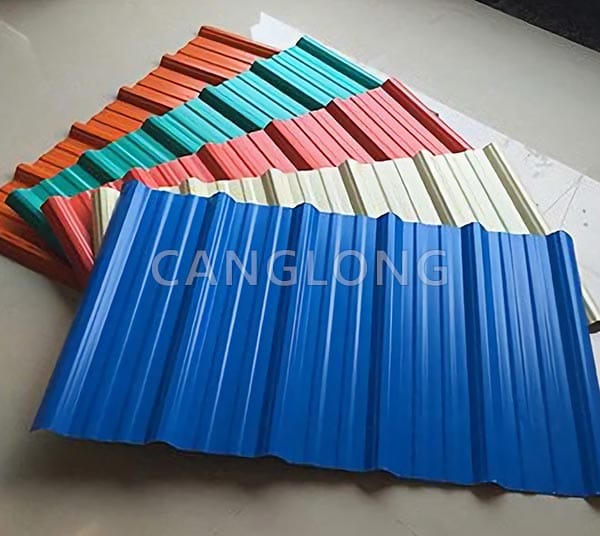
III. Core Advantages of Color Steel Single Sheet
Compared to traditional building materials (such as clay, concrete, and metal tiles), color steel single sheets offer significant advantages in terms of affordability, functionality, and environmental friendliness, precisely meeting the market’s demand for efficient construction.
3.1. Affordability
Low Initial Cost: The unit cost of a color steel single sheet is only 1/2-2/3 that of a clay tile (depending on the coating type). It also requires no additional supporting structures (such as concrete purlins), significantly reducing steel usage.
Low Maintenance Cost: The self-cleaning surface (PVDF coating) reduces residual stains from rainwater, and the weather-resistant design eliminates frequent renovations. Over a 25-year lifecycle, the average annual maintenance cost is over 40% lower than that of a clay tile.
3.2. Functionality
- Quick Installation: The modular design supports building-block construction. A single person can lay 50-80 square meters per day (traditional tiles require 2-3 people), shortening construction time by 30%-50%. This makes it particularly suitable for emergency reconstruction or temporary projects (such as disaster relief sites and temporary warehouses).
- Superior Protection: The dual protection system of plating and coating provides resistance to salt spray (≥1000 hours), humidity and heat (≥1500 hours), and acid resistance (no corrosion after 500 hours at pH 3-5). It can be used stably in the hot and humid climates of Southeast Asia, the high salt spray environments of the Middle East, and industrial pollution areas.
- Flexible Customization: Over 200 colors are available (covering the entire RAL color chart), and the wave shape, thickness, and length can be adjusted as needed (up to 12 meters). It meets the aesthetic requirements of commercial buildings (such as supermarkets and exhibition halls) or the functional needs of industrial settings (such as factories and equipment rooms).
3.3. Environmental Protection
- Recyclability: Both the base and coating are 100% recyclable, with a recycling rate of over 95% for galvanized steel sheets. Compared to clay tiles (non-recyclable) or concrete tiles (high energy consumption for production), carbon emissions are reduced by over 60%.
- Low-energy production: The continuous roller pressing process consumes only one-third the energy of traditional tile production, and produces zero dust or wastewater, meeting the environmental requirements of the EU CE certification, US ASTM standards, and the Middle East GCC certification.
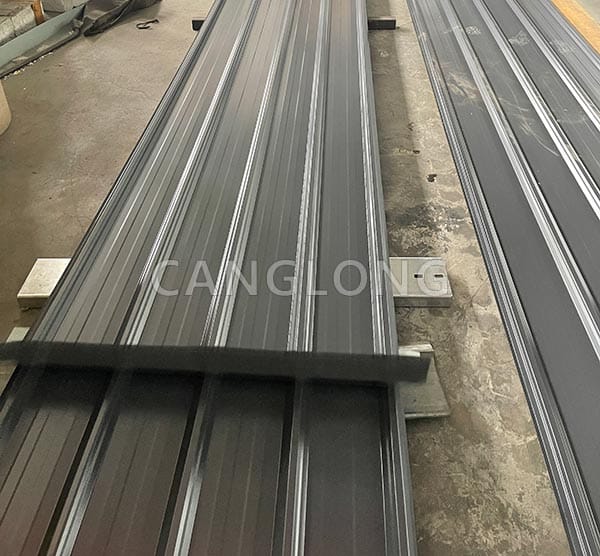
IV. Typical Application Scenarios for Color Steel Single Sheet
Leveraging the aforementioned advantages, the application of color-coated steel single sheet has expanded from the industrial sector to the commercial and residential markets. The following are market applications in three core scenarios:
4.1. Industrial Buildings
- Warehouses and Logistics Centers: Amazon Logistics Parks in the United States and DB Schenker warehouses in Germany widely use HDP color-coated steel roof sheet. Their large spans (10-15 meters without support) and quick installation can shorten construction periods by over two months, reducing initial investment costs.
- Factories: Southeast Asian electronics factories (such as the Samsung base in Vietnam) and Middle Eastern petrochemical plants (such as Saudi Aramco’s refineries) choose PVDF color steel single sheet. They withstand high temperatures, high humidity (above 40°C) and highly corrosive environments (sulfur-containing gases), and are guaranteed to be rust-free and leak-proof for 10 years.
4.2. Commercial Buildings
- Supermarkets and Retail Centers: European supermarket chains (such as Aldi in Germany) and Middle Eastern shopping malls (such as Dubai Mall) prefer SMP or HDP color-coated steel sheets. Customizable colors (such as red and blue) and streamlined, corrugated designs offer a cost-effective upgrade.
- Public Facilities: African hospitals (such as the Nairobi Medical Center in Kenya) and South American schools (such as the São Paulo Public School in Brazil) use trapezoidal color-coated steel sheets for wall cladding, balancing thermal insulation (reducing air conditioning energy consumption by 20%) and wind resistance (capable of withstanding force 10 winds).
4.3. Civilian Construction
- Prefabricated Housing and B&Bs: In post-disaster reconstruction projects in Japan and rural tourism in Australia, lightweight color steel single sheet (0.4mm thickness, 20mm corrugated height) weigh only one-fifth of traditional tiles (approximately 8kg/m2). Combined with rapid installation technology, temporary shelters can be erected within 72 hours.
- Roof Renovation: In the UK’s “Green Homes” program and self-built homes in rural Canada, homeowners are opting to replace old clay tiles with PVDF color steel single sheets. These tiles are 60% lighter and come with a 25-year warranty, meeting the requirements for subsidies under the “Low-Carbon Renovation” policy.
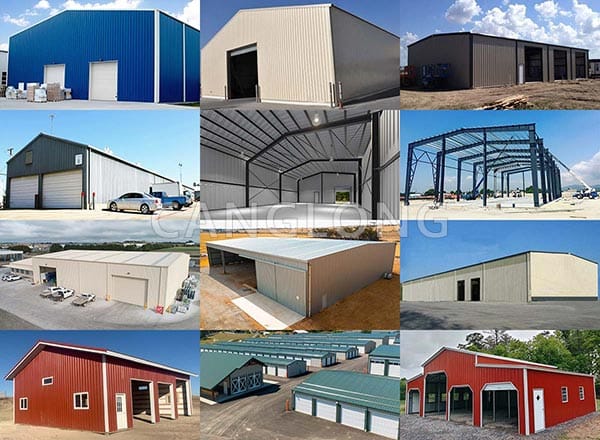
Conclusion
Against the backdrop of accelerating industrialization and green transformation in the construction industry, color steel single sheet with their core advantages of low cost, long life, easy installation, and adaptability to multiple scenarios, are penetrating beyond the industrial sector into a wider range of residential and commercial markets. For users, choosing a color-coated steel tile depends on the local climate (e.g., PVDF for rainy areas, deep-wave type for high-wind pressure areas), budget (PE is suitable for short-term projects, HDP/PVDF for long-term investments), and functional requirements (e.g., whether self-cleaning and UV resistance are required).
In the future, with the widespread adoption of integrated photovoltaic (BIPV) technology, color-coated steel sheet, which combine conductivity and weather resistance, may further expand their application. For example, photovoltaic color steel single sheet with integrated solar panels have been piloted on some European home rooftops, providing a one-stop solution for building energy supply and energy conservation. It is foreseeable that color-coated steel single sheet will become a representative example of the fusion of function and aesthetics in the global architectural field, continuously driving innovation and upgrading in the construction industry.
